weight AUDI A7 2013 Owners Manual
[x] Cancel search | Manufacturer: AUDI, Model Year: 2013, Model line: A7, Model: AUDI A7 2013Pages: 310, PDF Size: 77.45 MB
Page 6 of 310
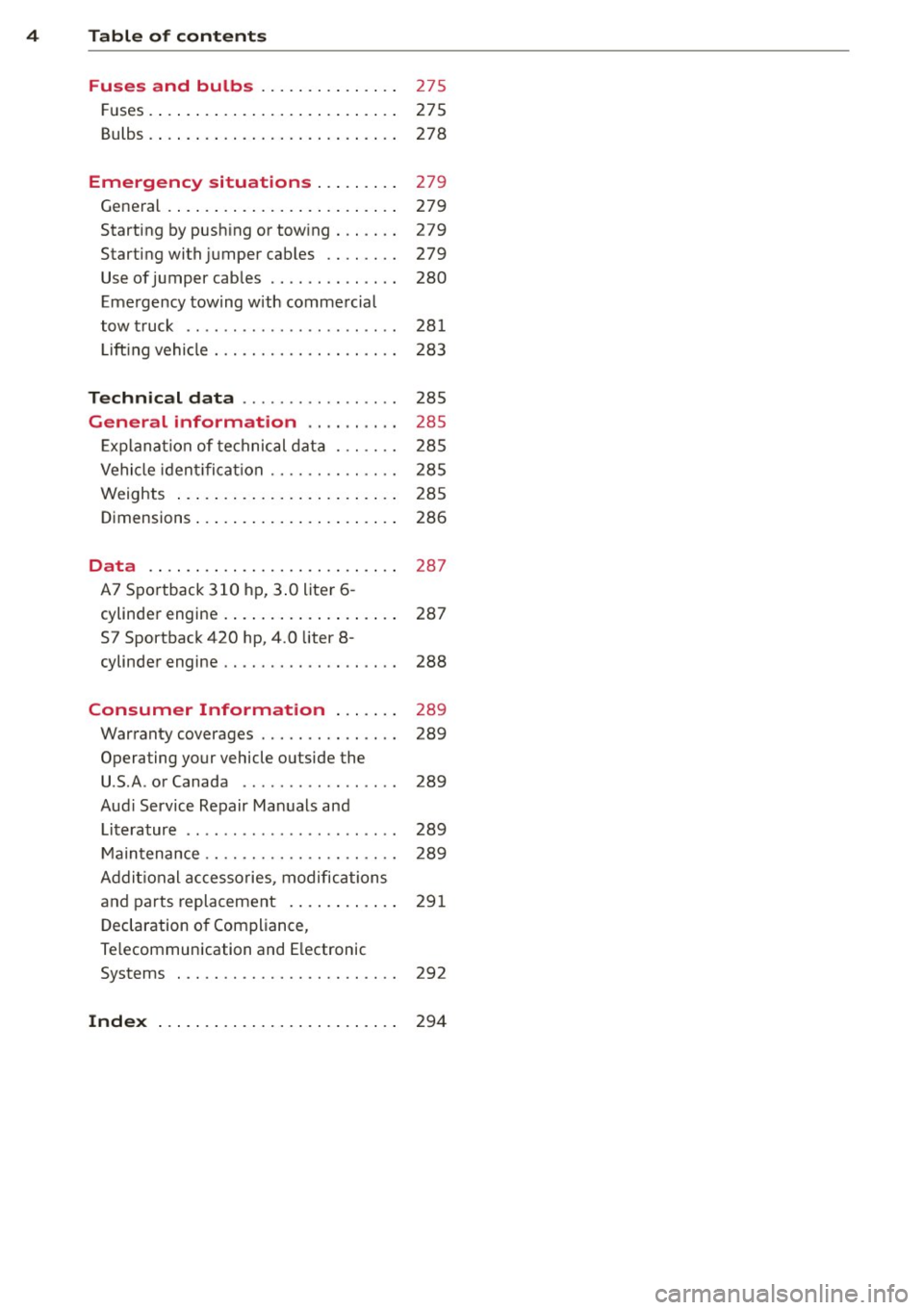
4 Table of contents
Fuses and bulbs ....... .. .. ... .
Fuses . ..... ... . ...... ... .. .. ... .
Bulbs . ... .. ... ... .... ... .. .. ... .
Emergency situations ... .. ... .
General .... ... .. ..... ... .. .. ... .
Starting by push ing or tow ing . .. .. . .
Starting with jumper cables .. .. .. . .
Use of jumper cab les .. .. .. .. .. .. . .
Eme rgency towing with commercial
tow truck .. ................ ... . .
Lift ing vehicle . ........... .... ... .
Technical data ............. .. . .
General information .. .. .. .. . .
Explana tion of te chnical data . .. ... .
Vehicle iden tifica tion .... ...... .. . .
Weights ... ... .. ..... ... .. .. ... .
Dimensions .... .. ..... ... .. .. ... .
Data .. .. .. .. .. .. .... ... .. .. .. . .
A7 Sportback 310 hp, 3 .0 liter 6-
cylinder engine . ....... ... .. .. ... .
S7 Sportback 420 hp, 4.0 liter 8-
cylinder engine ........... .. .. .. . .
Consumer Information ..... . .
Warranty coverages ....... .... ... .
Operating your vehicle outside the
U .S .A . or Canada .......... ... .. . .
Aud i Service Repair Man uals and 275
275
278
279 279
279
279
280
281 283
285 285
285
28 5
28 5
286
28 7
287
288
289 289
289
Literature . . . . . . . . . . . . . . . . . . . . . . . 289
M ain tenance . . . . . . . . . . . . . . . . . . . . . 289
Addi tional accesso ries , modifications
and parts replacement . . . . . . . . . . . . 291
D eclaration o f Compliance,
Te lecommunication and E lectronic
Systems . . . . . . . . . . . . . . . . . . . . . . . . 292
Index ..... ... . ...... ... .. .. .... 294
Page 62 of 310
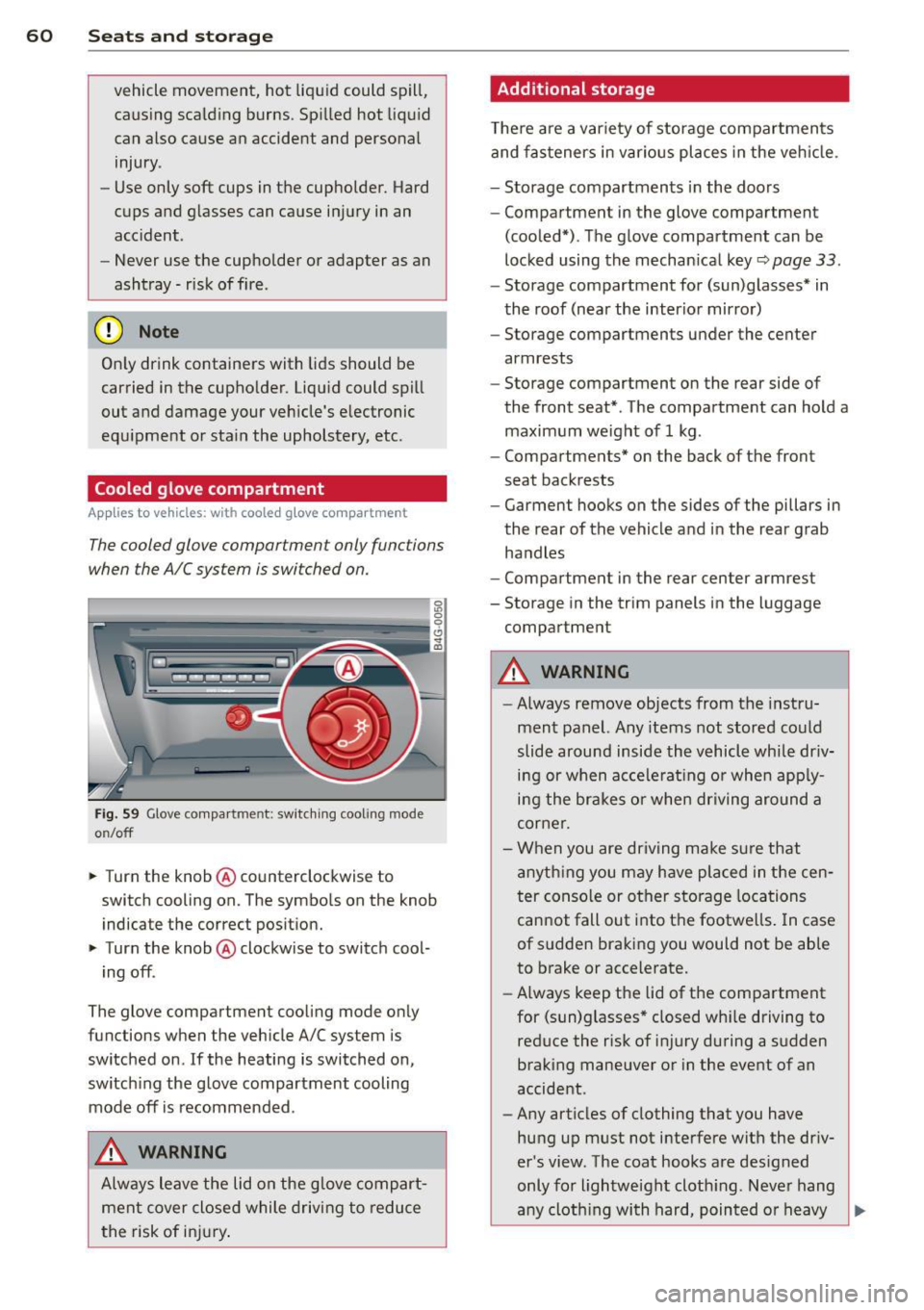
60 Seats and st o rage
vehicle movement, hot liqu id could spill,
causing scalding burns. Spilled hot liqu id
can also cause an accident and personal
injury .
- Use only soft cups in the cupholder. Hard
cups and glasses can cause inju ry in an
acc ident .
- Never use the cupholder or adapter as an
ashtray- risk of fire.
([) Note
Only drink containers with lids should be
carried in the cupho lder. Liqu id could spill
out and damage your veh icle's e lectronic
equ ipment or stain the upholste ry, etc.
Cooled glove compartment
Ap plies to vehicles: with coole d glove compa rtm ent
The cooled glove compartment only functions
when the AIC system is switched on.
Fig. 59 Glove compa rtment: switc hin g cooling mode
o n/off
~ Turn the knob@ counterclockwise to
switch cooling on. The symbols on the knob
indicate the correct pos ition.
~ Turn the knob @ clockwise to switch cool-
ing off .
The glove compartment cooli ng mode only
functions when the vehicle A/C system is
switched on .
If the heating is switched on,
switch ing the glove compartment cooling
mode off is recommended .
_& WARNING
Always leave the lid on the glove compart
men t cover close d while driving to reduce
t he risk of in jury.
Additional storage
The re are a var iety of storage compartmen ts
and fas teners in various pl aces in the veh icle.
- Storage compartments in the doors
- Compartment in the glove compartment
(coo led*) . The glove compartment can be
locked using the mechan ical key
r::;, page 33.
- Storage compartment for (sun)glasses* in
the roof (near the interior mirro r)
- Storage compartments under the center
armrests
- Storage compartment on the rear side of
the front seat* . The compartment can hold a
maximum weight of 1 kg .
- Compartments* on the back of the front
seat backrests
- Garment hooks on the sides of the pillars in
the rear of the vehicle and in the rear grab
handles
- Compartment in the rear center armrest
- Storage in the trim panels in the luggage
compartment
_& WARNING
-
- Always remove objects from the instru
ment panel. Any items not stored could
slide around inside the vehicle while dr iv
ing or when acce le rat ing or whe n app ly
ing the brakes o r when driving around a
corne r.
- When you are driving make su re that
anyth ing you may have placed in the cen
t er conso le or other storage locations
cannot fall out into the footwe lls . I n case
of sudden braki ng you would not be able
to brake or accelerate.
- Always keep the lid of the compartment
for (sun)glasses" closed wh ile driving to
reduce the risk of i njury during a su dden
braking maneuver or in the event of an
accident .
- Any articles of clothing that you have
hung up must not interfere with the driv
er's view. The coat hooks are des igned
only for lightwe ight cloth ing. Neve r hang
-
any cloth ing with hard, pointed or heavy ..,_
Page 64 of 310
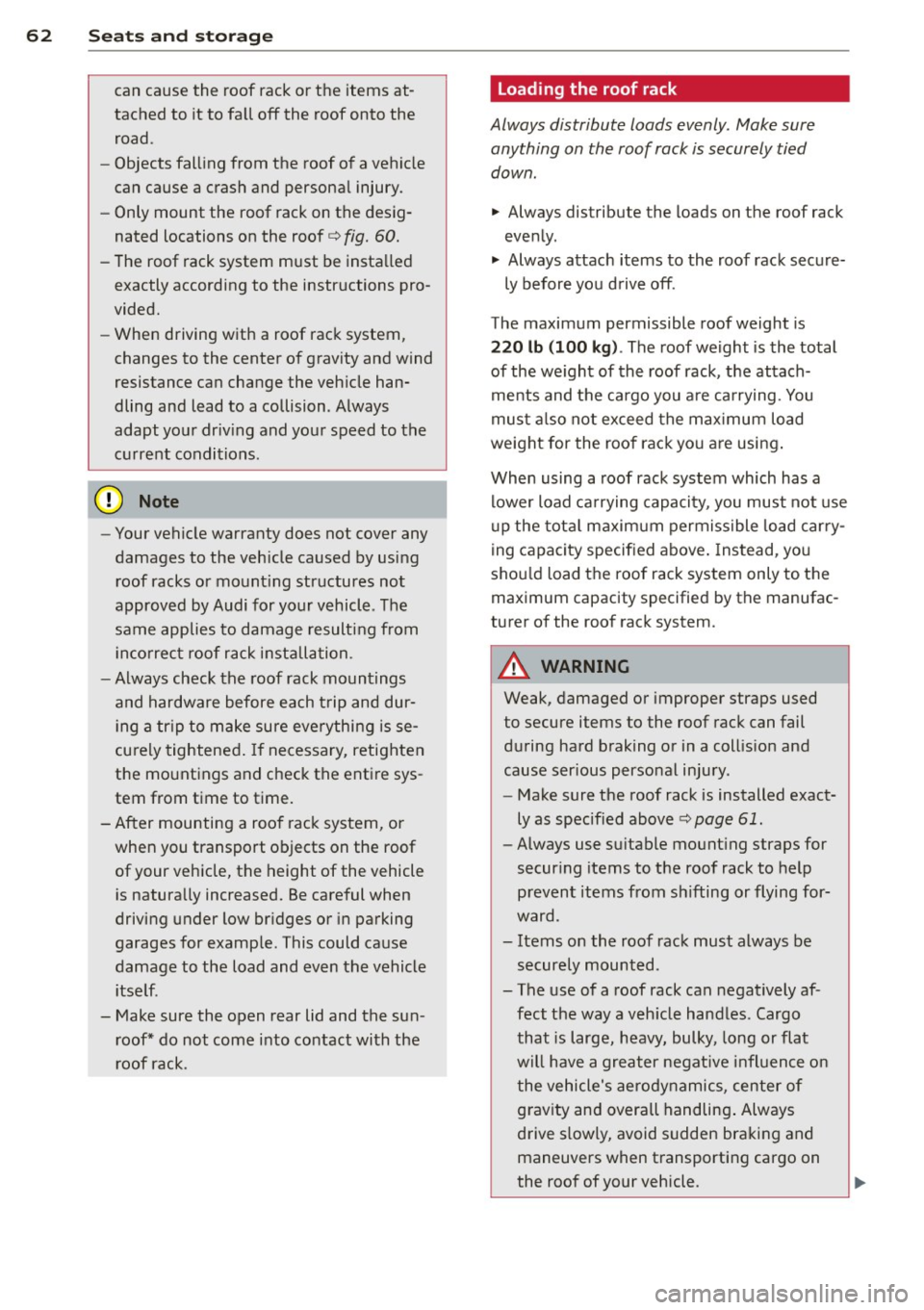
62 Seat s a nd s tor ag e
can cause the roof rack or the items at
tached to it to fall off the roof onto the road .
- Objects falling from the roof of a vehicle
can cause a crash and personal injury .
- Only mount the roof rack on the desig
nated locations on the roof
c> fig. 60.
-The roof rack system must be insta lled
exactly according to the instructions pro
vided.
- When driving with a roof rack system,
changes to the center of gravity and wind
resistance can change the veh icle han
dling and lead to a collision . Always
adapt your driv ing and your speed to the
cu rrent conditions .
@ Note
-Your vehicle warranty does not cover any
damages to the veh icle caused by using
r oof racks or mount ing structures not
approved by Audi for your vehicle . The
same applies to damage resulti ng from
i n co rrec t roof rack installation .
- Always check the roof rack mountings
and hardware before each t rip and dur
i ng a tr ip to make sure eve rything is se
cu rely tightened . If necessary, retighten
the mo untings and check the entire sys
tem from time to time.
- After mounting a roof rack system, or when you transport objects on the roof
of your ve hicle, the height of the vehicle
i s natura lly increased. Be careful when
driving under low br idges or i n parking
garages for examp le . This could cause
damage to the load and even the vehicle i tse lf.
- Make sure the open rear lid and the sun
r oof* do not come into contact with the
r oof rack .
Loading the roof rack
Always distribute loads evenly. Make sure
anything on the roof rack is securely tied
down .
.. Always distribu te the loads on the roof rack
eve nly .
.. Always attach items to the roof rack sec ure-
ly before yo u drive off.
The maximum permissible roof weight is
2 20 lb (100 kg ). The roof we ight is the total
of the we ight of the roof rack, t he attach
ments and the cargo you a re ca rrying. You
must also not exceed the max imum load
weight for the roof rack yo u are using .
When using a roof rack system which has a lower load ca rrying capaci ty, you must not use
u p the tot al maxim um permiss ible load car ry
ing capacity specif ied above . Ins tead, you
sho uld load the roof rack system only to the
maximum capacity specified by the manufac
turer of the roof rack system .
A WARNING
-Weak, damaged or improper straps used
to secure items to the roof rack can fail
during hard braking or in a coll is io n and
cause ser ious personal inju ry .
- Make sure the roof rack is installed exact
ly
as specified above i:> page 61.
-Always use su itable mount ing straps for
secur ing items to the roof rack to help
p revent items from sh ifting or flying for
ward .
- Items on the roof rack must always be securely mounted .
- The use of a roof rack can negatively af
fect the way a veh icle hand les . Cargo
that is large, heavy, bulky, long or flat
will h ave a greater negat ive i nfl uence on
t he vehicle's aerodynamics, center of
grav ity and overall handling . Always
drive s lowly, avoid sudden braking and
maneuvers when t ransporting cargo on
the roof of your vehicle .
ll>-
Page 65 of 310
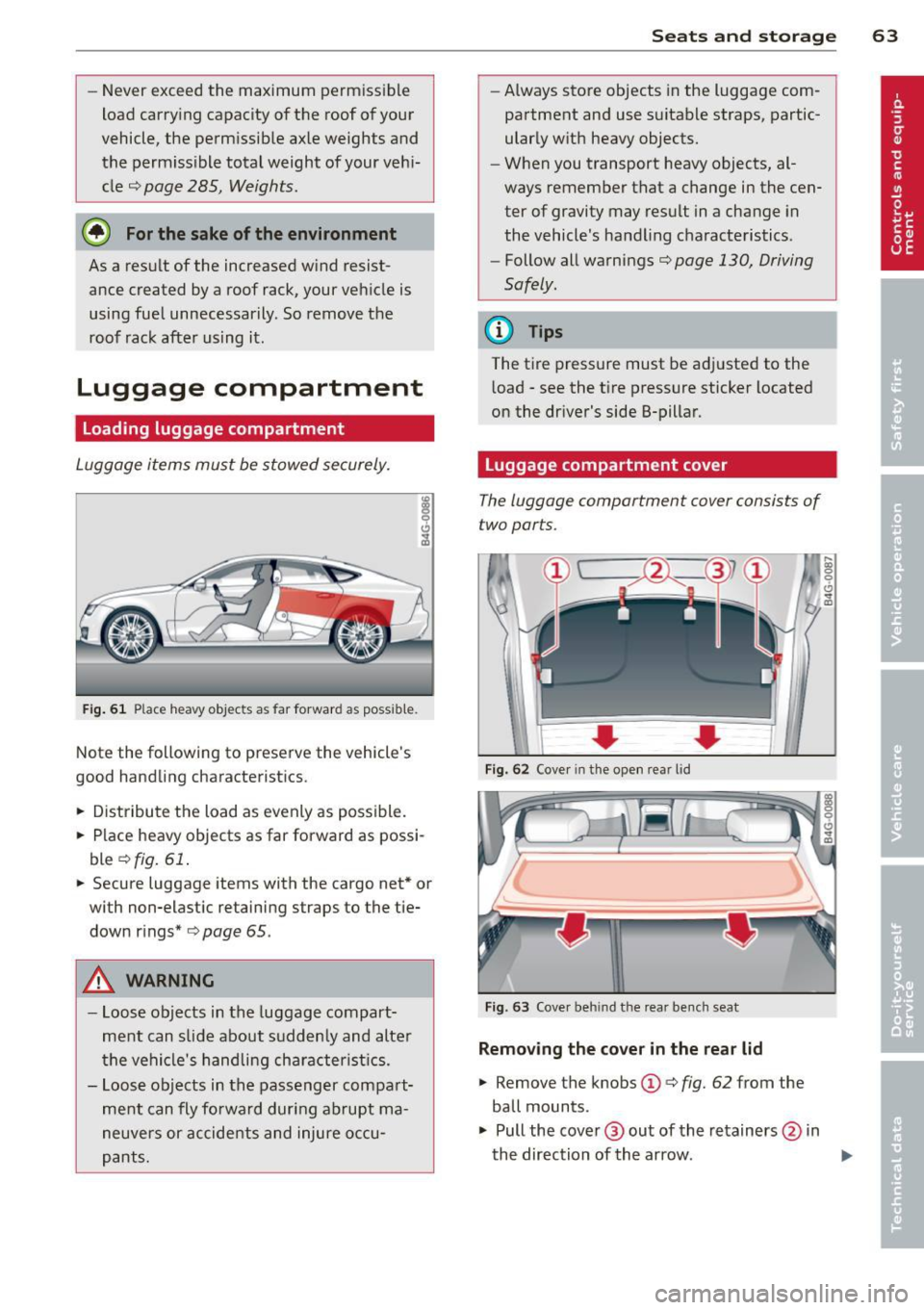
-Never exceed the maximum permissible
load carry ing capacity of the roof of your
vehicle, the perm issible axle weights and
the permiss ible total weight of your veh i
cle
c;, page 285, Weights.
@ For the sake of the environment
As a result of the increased wind resist ance created by a roof rack, your vehicle is
using fue l unnecessarily. So remove the
roof rack after using it.
Luggage compartment
Loading luggage compartment
Luggage items must be stowed securely.
Fig . 61 Place heavy objects as far forward as possib le.
Not e the following to preserve the vehicle's
good handling characterist ics .
.. Distribute the load as evenly as possible .
.. Place heavy objects as far forward as possi
ble
c;, fig. 61 .
.. Secure luggage items with the cargo net* or
with non-elastic retaining straps to the tie
down rings*
c;, page 65.
A WARNING
-Loose objects in the luggage compart
ment can slide about suddenly and alter
the vehicle's handling characterist ics.
- Loose objects in the passenger compart
ment can fly forward during abrupt ma
neuvers or accidents and injure occu
pants.
Seats and storage 63
-Always store objects in the luggage com
partment and use suitable straps, partic
ularly with heavy objects.
- When you transport heavy objects, al
ways remember that a change in the cen
ter of gravity may result in a change in
the vehicle's handling characteristics.
- Follow all warnings
c;, page 130, Driving
Safely.
(D Tips
The tire pressure must be adjusted to the
load - see the tir e pressure sticker located
on the driver's side 8-pillar.
Luggage compartment cover
The luggage compartment cover consists of
two parts.
... ...
Fig. 62 Cover in the open rear lid
Fig. 63 Cove r behind the rear bench seat
Removing the cover in the rear lid
.. Remove the knobs (D c;, fig. 62 from the
ball mounts .
.. Pull the cover @ out of the retainers @ in
the direction of the arrow.
~
Page 67 of 310
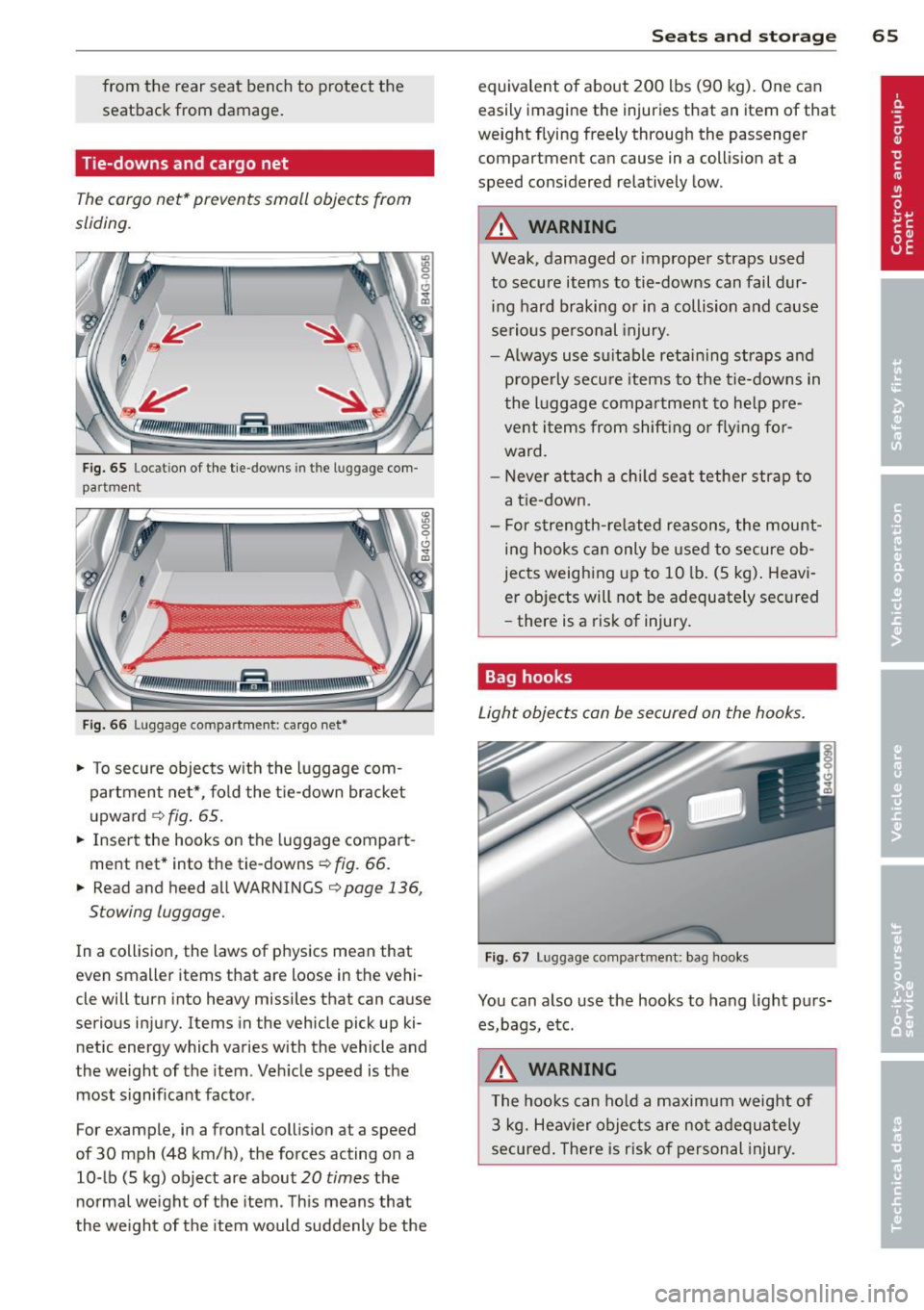
from the rear seat bench to protect the
seatback from damage.
Tie-downs and cargo net
The cargo net* prevents small objects from
sliding.
Fig. 65 Locat ion of the tie-downs in the luggage com
partment
Fig. 66 Luggage compartment: cargo net*
.. To secure objects w ith the luggage com
partment net*, fo ld the t ie-down bracket
u pward
¢ fig. 65 .
.. Insert the hooks on the luggage compart
ment net* into the tie-downs
¢ fig. 66 .
.. Read and heed all WARNINGS
¢page 136,
Stowing luggage.
In a collision, the laws of physics mean that
even smaller items that are loose in the vehi
cle will turn into heavy missiles that can cause
serious injury. Items in the vehicle pick up ki
netic energy which varies with the vehicle and
the we ight of the item . Veh icle speed is the
most significant factor.
For example, in a frontal collision at a speed
of 30 mph (48 km/h), the forces acting on a
10-lb (S kg) object are about
20 times the
normal weight of the item . T his means that
the weight of the item would suddenly be the
S ea ts a nd s to rage 65
equivalent of about 200 lbs (90 kg). One can
easily imagine the injuries that an item of that
weight flying freely through the passenger
compartment can cause in a collision at a
speed considered relatively low.
A WARNING
Weak, damaged or improper straps used
to secure items to tie-downs can fail dur
ing hard braking or in a collision and cause
serious personal injury.
- Always use su itab le retaining straps and
prope rly secure items to the tie-downs in
the l uggage compartment to he lp pre
vent items from shift ing o r fly ing for
ward .
- Never attach a chi ld seat tether str ap to
a tie-down.
- For strength-re lated reasons, the mount
ing hooks can only be used to secure ob
jects weighing up to 10 lb. (5 kg) . Heavi
er objects will not be adequately secured
- there is a risk of injury.
Bag hooks
Light objects can be secured on the hooks.
Fig. 67 Luggag e co mpa rtment: bag hooks
You can also use the hooks to hang light purs
es,bags, etc.
A WARNING
The hoo ks can ho ld a maximum weight of
3 kg. Heav ier objects are not adequa tely
secured . There is risk of personal injury.
Page 82 of 310

80 On the road
Starting and automatically releasing the
par king brake
.. When you sta rt to drive as usua l, the park
ing brake is automatically re leased and your
vehicle begins to move.
When stopping at a traffic signa l or stopping
in city traffic, the parking brake can be ap
plied. The veh icle does not have to be held
with the footbrake. The parking brake elimi nates the tendency to creep with a drive range
engaged . As soon as you dr ive off as usual,
the park ing brake is released automatically
and the veh icle sta rts to move .
Starting on slopes
When starting on inclines, the starting assist
prevents the vehicle from unintentionally roll
ing back . The braking force of the parking
brake is not released until sufficient dr iving
fo rce has been bu ilt up at the whee ls.
(D Tips
For safety reasons, the park ing brake is re
leased automatically only when the dr iv
er 's safety belt is engaged in the buck le.
Starting off with a trailer
To prevent rolling back unintentionally on an
incline, do the following:
.. Keep the switch
accelerator. The park ing brake stays applied
and prevents the vehicle from rolling back
ward.
.. You can release the switch
C®l once you are
sure that you a re developing enough for
ward momentum at the wheels as you de
press the accelerator .
Depending on the weight of the rig (vehicle
and trai ler) and the seve rity of the incline, you
may roll backwards as you start. You can pre
vent rolling backwards by holding the parking brake switch(®) pulled out and accelerating -
just as you would when starting on a hill with a conventional hand brake .
Emergency braking
In the event that the conventional brake sys
tem fails or locks .
.. In an emergency, pull the switch C®l and
con tinue to pull it to slow your vehicle down
w ith the park ing brake.
.. As soon as you release the switch (®) or ac-
celerate, the brak ing process stops.
If you pull the switch C®l and hold it above a
speed of about 5 mph (8 km/h), the emergen
cy brak ing funct ion is initiated . T he vehicle is
braked at all fou r whee ls by activating the hy
draulic brake system. The brake performance
is similar to making an emergency stop~&. .
In order not to act ivate the emergency brak
ing by mis take, an audib le warning tone (buz
zer) sounds whe n the switch(®) is pulled . As
soon as the sw itch C®l is released , or the accel
erator pedal is depressed, emergency braking
stops.
_& WARNING
-Emergency braking should only be used in
an emergency, when the normal foot brake
has failed or the brake pedal is obstructed.
Using the parking brake to perform emer
gency braking will slow your veh icle down
as if you had made a full brake application .
The laws of physics cannot be suspended
even with ESC and its associated compo
nents (ABS, ASR, EDL) . In corners and
when road or weather conditions are bad,
a full brake application can cause the vehi
cle to skid or the rear end to break away -
risking an accident.
Start-Stop-System
Description
Applies to vehicles: with Start -Stop -System
T he Start -Stop-System can help increase fuel
economy and reduce CO 2 emissions.
In the Start-Stop-mode, the engine shuts off
automat ically when the veh icle is stopped,
such as at a traffic light. The ignition remains .,.
Page 138 of 310
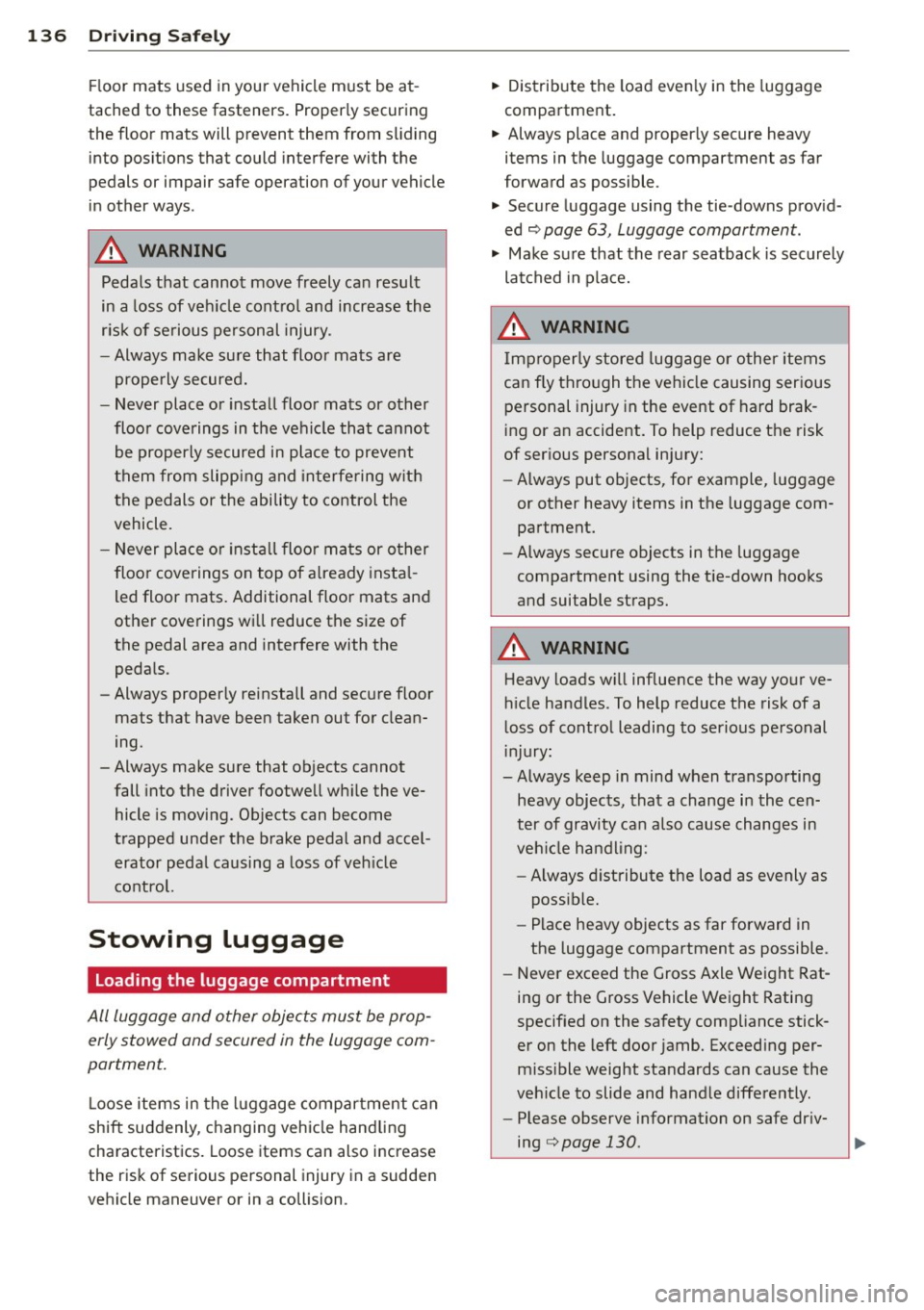
136 Driving Saf ely
Fl oor mats used in your vehicle must be at
tached to these fasteners. Proper ly securing
the floor mats will prevent them from s liding
into pos itions that could interfere with the
pedals or impair safe operation of your vehicle
in other ways .
A WARNING
Pedals that cannot move freely can result
in a loss of veh icle contro l and increase the
r isk of serious personal injury .
- Always make sure that floor mats are
properly secured.
- Never place or insta ll floor mats or other
floor coverings in the vehicle that cannot be properly secured in place to prevent
them from slipping and interfering w ith
the pedals or the ability to control the
vehicle.
- Never place o r insta ll floor ma ts or other
floor coverings on top of a lready insta l
led floor mats. Additional floor mats and
other coverings w ill reduce the size of
the pedal area and interfere with the
pedals.
- Always properly reinstall and secure floor
mats that have been taken out for clean
ing.
- Always make sure that objects cannot fall into the driver footwell wh ile the ve
hicle is moving. Objects can become
trapped under the brake pedal and accel
erator peda l causing a loss of veh icle
control.
Stowing luggage
Loading the luggage compartment
All luggage and other objects must be prop
erly stowed and secured in the luggage com
partment.
L oose items in the luggage comp art ment can
shift suddenly, changing veh icle hand ling
characteristics. Loose items can also increase
the risk of serious personal injury in a sudden
vehicle maneuver or in a collision . ..
Distribute the load even ly in the luggage
compartment .
.. Always place and proper ly secure heavy
items in the luggage compartment as far
forward as possible .
.. Secure luggage using the tie -downs prov id
ed
¢ page 63, Luggage compartment.
.. Make s ure that the rear seatback is securely
la tc hed in place.
A WARNING
Imp roperly store d luggage or other items
can fly thro ugh the vehi cle causing ser ious
personal injury in the event of hard brak
i ng or an accident. To help reduce the risk
of ser ious personal in jury:
- Always put objects, fo r example, luggage
or other heavy items in the luggage com pa rtment.
- Always secure objects in the luggage
compartment using the t ie-down hooks
and suitable straps.
A WARNING
=
Heavy loads w ill influence the way your ve-
hi cle handles . To help reduce the risk of a
l oss of contro l leading to serious pe rsonal
i njury :
-Always keep in mind when transporting
heavy objects, that a change i n the cen
ter of gravity can also cause changes in
veh icle ha ndling:
- Always distribute the load as evenly as
poss ible.
- Place heavy objects as far forward in
the luggage compartment as possible .
- Never exceed the Gross Axle Weight Rat
ing or the Gross Vehicle We ight Rating
specified on the safety compliance stick
er on the left door jamb. Exceed ing per
miss ible weight standards can cause the
veh icle to slide and handle differently .
- Please observe information on safe dr iv
ing¢
page 130.
Page 139 of 310
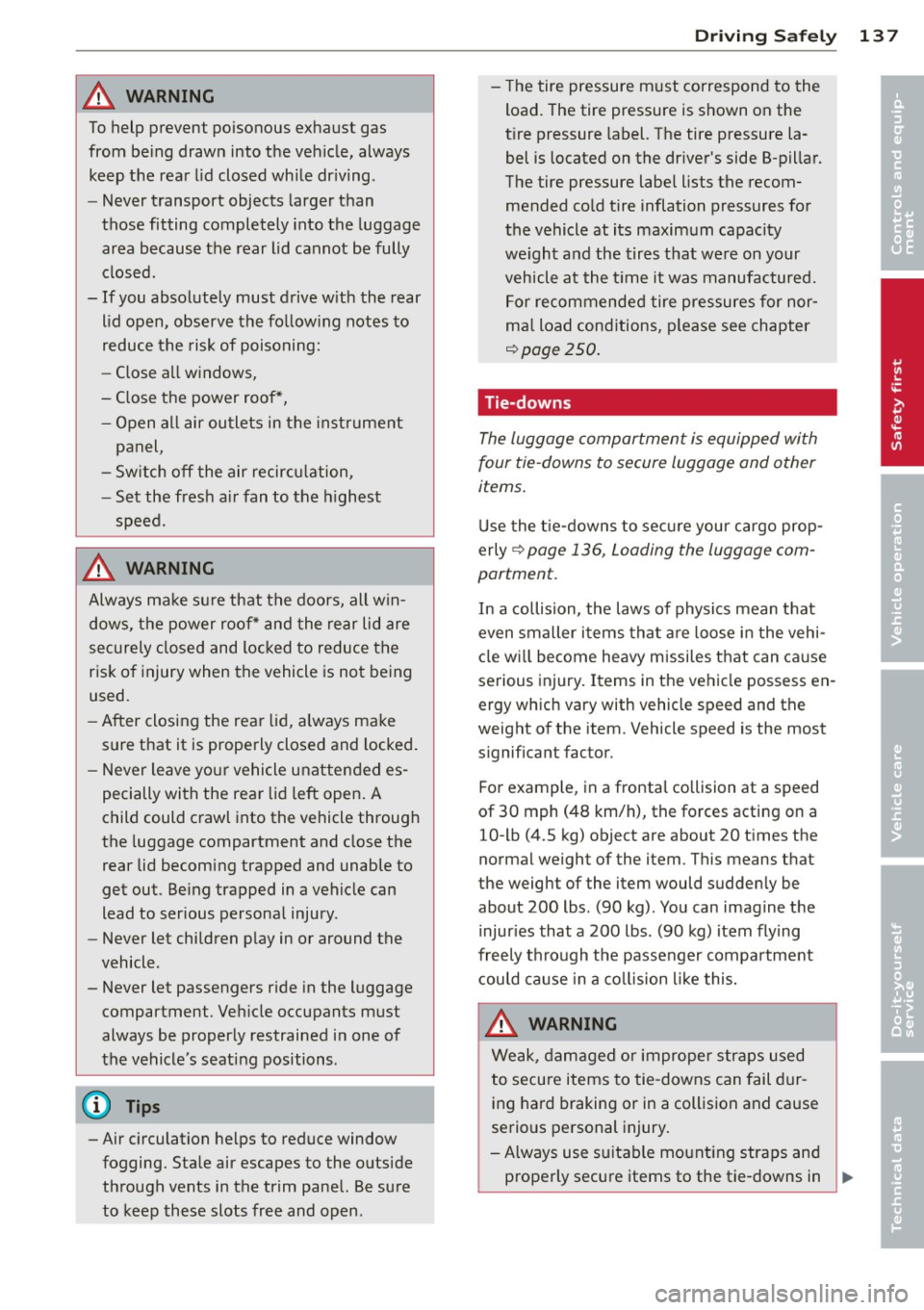
A WARNING ,~
To help prevent poisonous exhaust gas
from being drawn into the vehicle, always
keep the rear lid closed while driving .
- Never transport objects larger than
those fitting completely into the luggage
area because the rear lid cannot be fully
closed.
- If you absolutely must drive with the rear
lid open, observe the following notes to
reduce the risk of poisoning:
- Close all windows,
- Close the power roof*,
- Open all air outlets in the instrument
panel,
- Switch off the air recirculation,
- Set the fresh air fan to the highest
speed.
A WARNING
Always make sure that the doors, all win dows, the power roof* and the rear lid are
securely closed and locked to reduce the
risk of injury when the vehicle is not being
used.
- After closing the rear lid, always make
sure that it is properly closed and locked.
- Never leave your vehicle unattended es
pecially with the rear lid left open. A
child could crawl into the vehicle through
the luggage compartment and close the
rear lid becoming trapped and unable to
get out. Being trapped in a vehicle can
lead to serious personal injury.
- Never let children play in or around the
vehicle .
- Never let passengers ride in the luggage
compartment. Vehicle occupants must
always be properly restrained in one of
the vehicle's seating positions.
Gj) Tips
-Air circulation helps to reduce window fogging. Stale air escapes to the outside
through vents in the trim panel. Be sure
to keep these slots free and open .
-
Driving Safely 137
-The tire pressure must correspond to the
load. The tire pressure is shown on the
tire pressure label. The tire pressure la
bel is located on the driver's side B-pillar.
The tire pressure label lists the recom
mended cold tire inflation pressures for
the vehicle at its maximum capacity
weight and the tires that were on your
vehicle at the time it was manufactured. For recommended tire pressures for nor
mal load conditions, please see chapter
r:!)page250.
Tie-downs
The luggage compartment is equipped with
four tie-downs to secure luggage and other
items.
Use the tie-downs to secure your cargo prop
erly<>
page 136, Loading the luggage com
partment.
In a collision, the laws of physics mean that
even smaller items that are loose in the vehi
cle will become heavy missiles that can cause
serious injury. Items in the vehicle possess en
ergy which vary with vehicle speed and the
weight of the item. Vehicle speed is the most
significant factor.
For example , in a frontal collision at a speed
of 30 mph (48 km/h), the forces acting on a 10-lb (4.5 kg) object are about 20 times the
normal weight of the item. This means that
the weight of the item would suddenly be about 200 lbs. (90 kg) . You can imagine the
injuries that a 200 lbs . (90 kg) item flying
freely through the passenger compartment
could cause in a collision like this.
A WARNING
Weak, damaged or improper straps used
to secure items to tie-downs can fail dur
ing hard braking or in a collision and cause
serious personal injury.
-Always use suitable mounting straps and properly secure items to the tie-downs in
'
•
•
Page 143 of 310
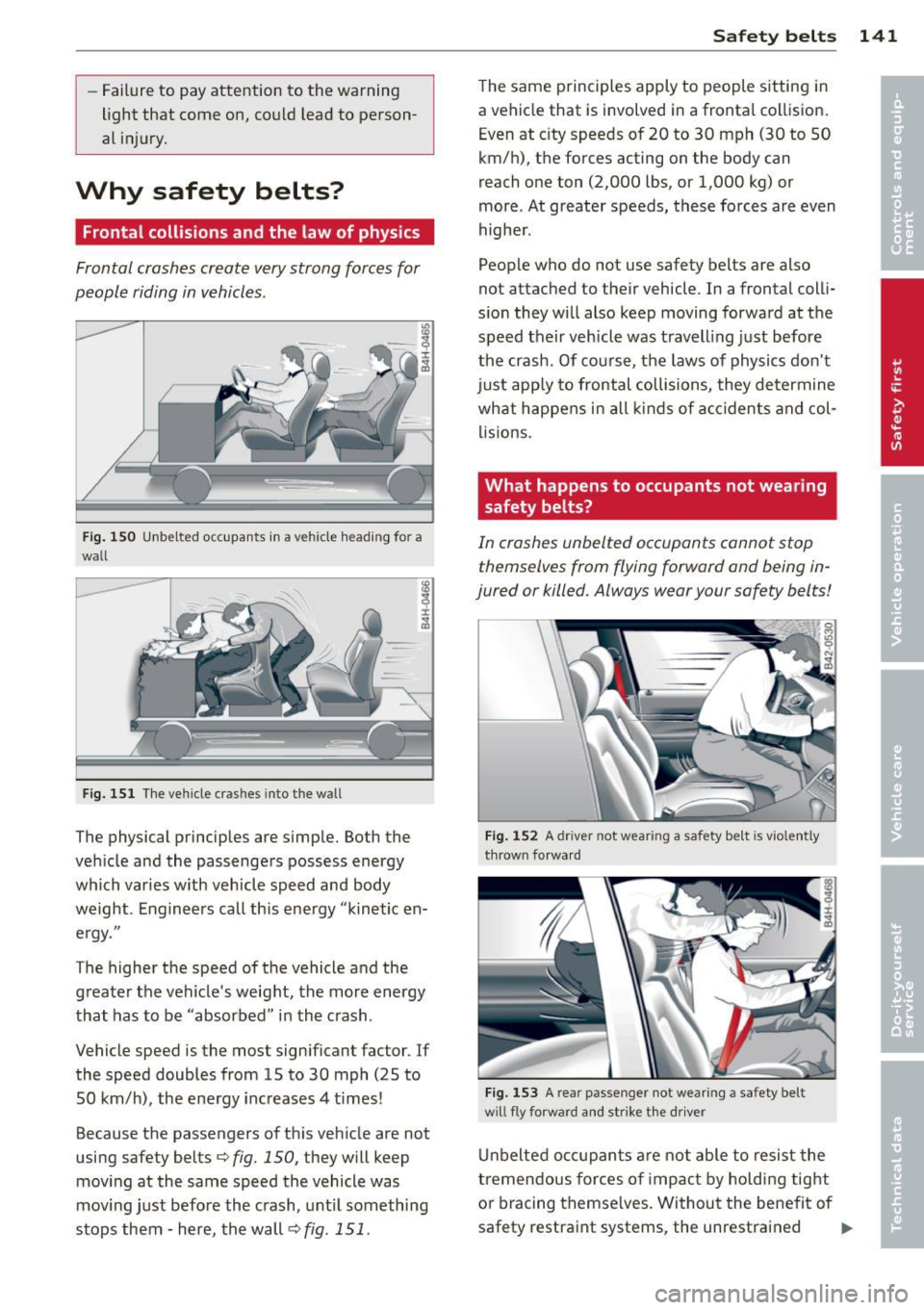
-Failure to pay attention to the warning
light that come on, could lead to person
al injury.
Why safety belts?
Frontal collisions and the law of physics
Frontal crashes create very strong forces for
people riding in vehicles .
Fig. 150 Unbe lted occupants in a ve hicle head ing for a
wall
Fig. 1 51 The vehicle cras hes into the wall
The physical principles are simple. Both the
veh icle and the passengers possess energy
which varies w ith veh icle speed and body
weight . Engineers call this energy "kinetic en
e rgy."
The higher the speed of the vehicle and the
greater the vehicle's weight, the more energy
that has to be "absorbed" in the crash .
Vehicle speed is the most significant factor . If
the speed doubles from 15 to 30 mph (25 to
50 km/h), the ene rgy increases 4 t imes!
Because the passengers of th is veh icle are not
using safety belts¢
fig. 150, they will keep
mov ing at the same speed the vehicle was
mov ing just befo re the crash, unt il something
stops them - here, the wall ¢
fig. 151.
Safety belts 141
The same principles apply to people s itting in
a vehicle that is involved in a frontal coll ision .
Even at c ity speeds of 20 to 30 mph (30 to 50
km/h), the forces acting on the body can
reach one ton (2,000 lbs, or 1,000 kg) or
more . At greater speeds, these fo rces are even
highe r.
Peop le who do not use safety belts are also
not attached to their vehicle . In a frontal colli
s ion they will also keep moving forward at the
speed their veh icle was travel ling just before
the crash . Of co urse, the laws of physics don't
just app ly to frontal collisions, they determine
what happens i n all k inds of a cc ident s and col
li s ions.
What happens to occupants not wearing
safety belts?
In crashes unbelted occupants cannot stop
themselves from flying forward and being in
jured or killed. Always wear your safety belts!
F ig . 1 52 A driver not wea ring a safety be lt is vio lently
th row n forwa rd
F ig. 153 A rear passenger not wearing a sa fety belt
w ill fly forward a nd strike the d river
Un belted oc cupants a re not able to resist the
tremendous forces o f impact by hold ing tight
o r bracing themse lves. Without the benefit of
safety restraint systems, the unrestra ined .,..
Page 153 of 310
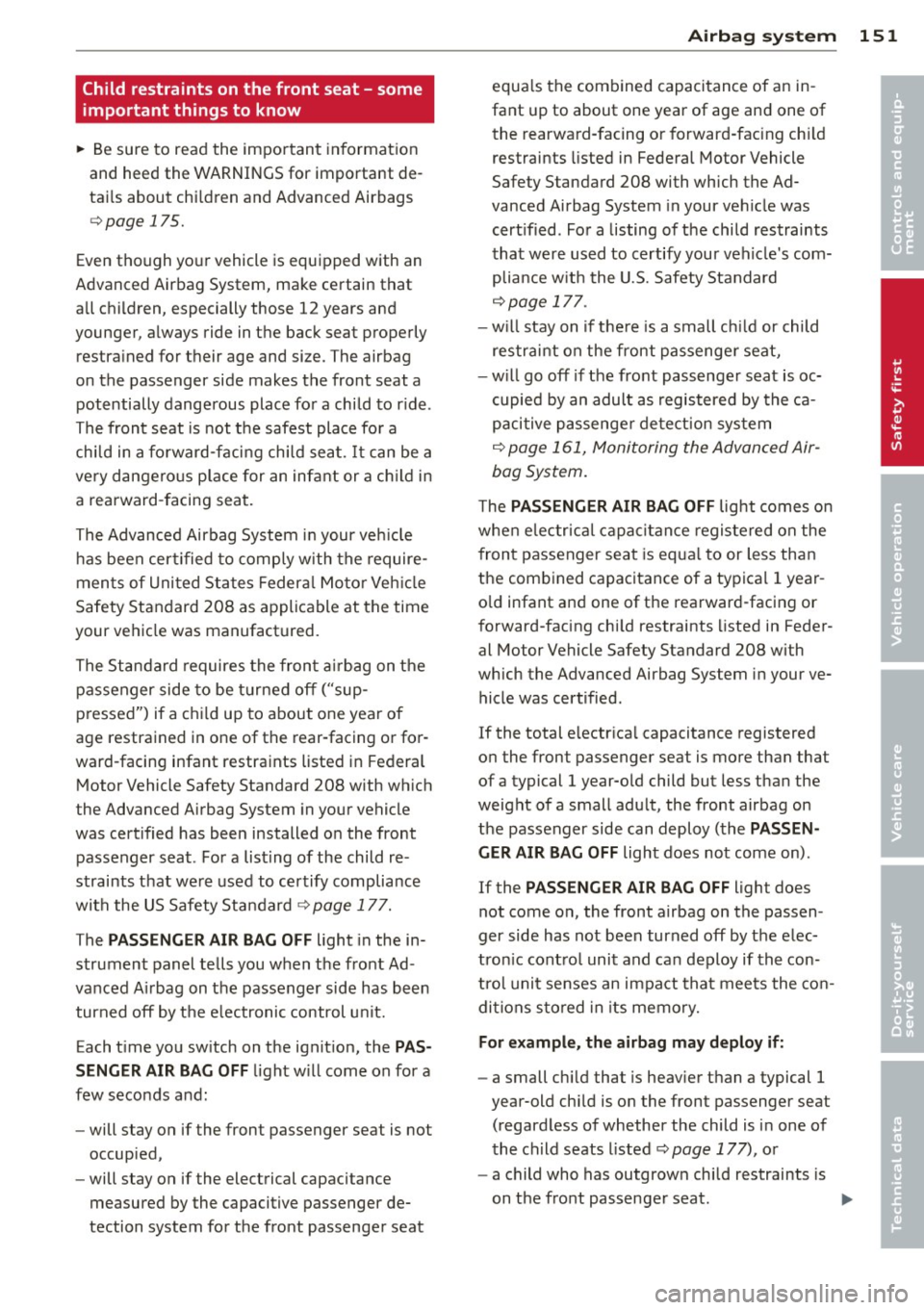
Child restraints on the front seat - some
important things to know
.. Be sure to read the important information
and heed the WARNINGS for important de
tails about chi ldren and Advanced Airbags
~ page 175.
Even though your vehicle is equipped with an
Advanced Airbag System, make certain that
a ll chi ldren, especially those 12 years and
younger, always ride in the back seat properly restrained for their age and size. The airbag
on the passenger side makes the front seat a potentially dangerous place for a child to r ide .
The front seat is not the safest place fo r a
chi ld in a fo rward-facing chi ld seat. It can be a
very dange ro us p lace for an infant or a ch ild in
a rearward -facing seat.
The Advanced Airbag System i n your veh icle
has been cert ified to comp ly with the require
men ts of United States Federa l Mo tor Veh icle
Safety Standard 208 as applicable at the time
your vehicle was manufactured.
The Standard requires the front a irbag on the
passenger side to be t urned off ("sup
p ressed") if a child up to about one year of
age restrained in one of the rear -facing or for
ward -facing infant restraints listed i n Federal
Motor Vehicle Safety Standard 208 with wh ich
the Advanced Airbag System in your vehicle
was certified has been installed o n the front
passenger seat. For a listing of the child re
straints that were used to certify compliance
with the US Safety Standard ~
page 177.
The PASS ENG ER AIR BAG OFF light in the in
strument panel tells you when the front Ad
vanced A irbag on the passenger side has been
turned off by the e lectronic control u nit.
Each t ime you sw itch on the ignit ion, the
PAS
SENGER AIR BAG OFF
light w ill come on for a
few seconds and:
- will stay on if the front passenger seat is not
occupied,
- will stay on if the electrical capacitance
measured by the capacitive passenger de
tection system for the front passenger seat
A irbag sys tem 151
equa ls the combined capacitance of an in
fant up to about one year of age and one of the rearward-facing or forward-facing ch ild
restraints listed in Federal Motor Vehicle
Safety Standard 208 with which the Ad
vanced Airbag System in your ve hicle was
cert ified. For a listing of the child restraints
that were used to certify your vehicle's com p lia nce w ith the U.S. Safety Standard
~page 177.
-w ill stay on if t he re is a small ch ild or child
restrai nt on the front passenge r seat,
- w ill go off if the front passenger seat is oc
cupied by an adult as registered by the ca
pacitive passenger de tection system
~ page 161, Monitoring the Advanced Air
bag System.
T he PASSENGER AIR BAG OFF lig ht comes on
when e lec trica l capacitance registe red on the
front passenger seat is equa l to or less than
the combined capacitance of a typical 1 year
o ld infant and one of the rearward-facing or
forward -facing chi ld restraints listed in Feder
al Motor Vehicle Safety Standard 208 with
which the Advanced Airbag System in your ve
hicle was certified.
If the total e lectr ica l capacitance registered
on the front passenger seat is more than that
of a typical 1 year-o ld child but less than the
weight of a small adu lt, the front airbag on
the passenger side can deploy (the
PASSEN
GER AIR BAG OFF
light does not come on).
If the
PASSENGER AIR BAG OFF light does
not come on, the front airbag on the passen
ger side has not been turned off by the e lec
tron ic contro l unit and can deploy if the con
t rol unit senses an impact that mee ts the co n
di tions s to red in its memo ry.
For example, th e airbag may deploy if:
-a small ch ild that is heav ier than a typical 1
year-old chi ld is on the front passenger seat
(regard less of whether the child is i n one of
the ch ild seats listed~
page 177), or
- a child who has outgrown child restraints is
on the front passenger seat.
IIJ,
•
•